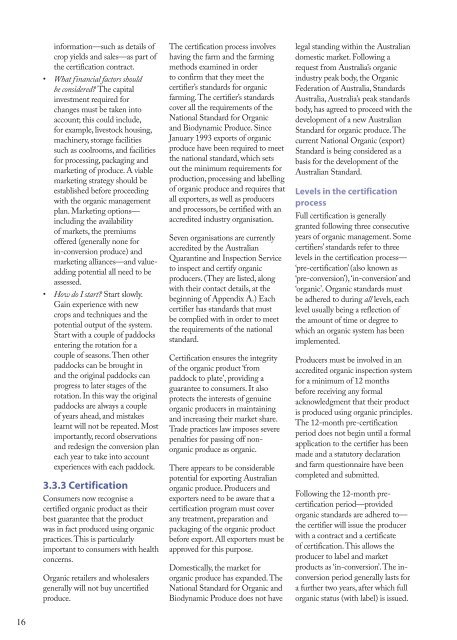4. Organic vegetable production
4. Organic vegetable production
4. Organic vegetable production
You also want an ePaper? Increase the reach of your titles
YUMPU automatically turns print PDFs into web optimized ePapers that Google loves.
information—such as details of<br />
crop yields and sales—as part of<br />
the certification contract.<br />
• What financial factors should<br />
be considered? The capital<br />
investment required for<br />
changes must be taken into<br />
account; this could include,<br />
for example, livestock housing,<br />
machinery, storage facilities<br />
such as coolrooms, and facilities<br />
for processing, packaging and<br />
marketing of produce. A viable<br />
marketing strategy should be<br />
established before proceeding<br />
with the organic management<br />
plan. Marketing options—<br />
including the availability<br />
of markets, the premiums<br />
offered (generally none for<br />
in-conversion produce) and<br />
marketing alliances—and valueadding<br />
potential all need to be<br />
assessed.<br />
• How do I start? Start slowly.<br />
Gain experience with new<br />
crops and techniques and the<br />
potential output of the system.<br />
Start with a couple of paddocks<br />
entering the rotation for a<br />
couple of seasons. Then other<br />
paddocks can be brought in<br />
and the original paddocks can<br />
progress to later stages of the<br />
rotation. In this way the original<br />
paddocks are always a couple<br />
of years ahead, and mistakes<br />
learnt will not be repeated. Most<br />
importantly, record observations<br />
and redesign the conversion plan<br />
each year to take into account<br />
experiences with each paddock.<br />
3.3.3 Certification<br />
Consumers now recognise a<br />
certified organic product as their<br />
best guarantee that the product<br />
was in fact produced using organic<br />
practices. This is particularly<br />
important to consumers with health<br />
concerns.<br />
<strong>Organic</strong> retailers and wholesalers<br />
generally will not buy uncertified<br />
produce.<br />
The certification process involves<br />
having the farm and the farming<br />
methods examined in order<br />
to confirm that they meet the<br />
certifier’s standards for organic<br />
farming. The certifier’s standards<br />
cover all the requirements of the<br />
National Standard for <strong>Organic</strong><br />
and Biodynamic Produce. Since<br />
January 1993 exports of organic<br />
produce have been required to meet<br />
the national standard, which sets<br />
out the minimum requirements for<br />
<strong>production</strong>, processing and labelling<br />
of organic produce and requires that<br />
all exporters, as well as producers<br />
and processors, be certified with an<br />
accredited industry organisation.<br />
Seven organisations are currently<br />
accredited by the Australian<br />
Quarantine and Inspection Service<br />
to inspect and certify organic<br />
producers. (They are listed, along<br />
with their contact details, at the<br />
beginning of Appendix A.) Each<br />
certifier has standards that must<br />
be complied with in order to meet<br />
the requirements of the national<br />
standard.<br />
Certification ensures the integrity<br />
of the organic product ‘from<br />
paddock to plate’, providing a<br />
guarantee to consumers. It also<br />
protects the interests of genuine<br />
organic producers in maintaining<br />
and increasing their market share.<br />
Trade practices law imposes severe<br />
penalties for passing off nonorganic<br />
produce as organic.<br />
There appears to be considerable<br />
potential for exporting Australian<br />
organic produce. Producers and<br />
exporters need to be aware that a<br />
certification program must cover<br />
any treatment, preparation and<br />
packaging of the organic product<br />
before export. All exporters must be<br />
approved for this purpose.<br />
Domestically, the market for<br />
organic produce has expanded. The<br />
National Standard for <strong>Organic</strong> and<br />
Biodynamic Produce does not have<br />
legal standing within the Australian<br />
domestic market. Following a<br />
request from Australia’s organic<br />
industry peak body, the <strong>Organic</strong><br />
Federation of Australia, Standards<br />
Australia, Australia’s peak standards<br />
body, has agreed to proceed with the<br />
development of a new Australian<br />
Standard for organic produce. The<br />
current National <strong>Organic</strong> (export)<br />
Standard is being considered as a<br />
basis for the development of the<br />
Australian Standard.<br />
Levels in the certification<br />
process<br />
Full certification is generally<br />
granted following three consecutive<br />
years of organic management. Some<br />
certifiers’ standards refer to three<br />
levels in the certification process—<br />
‘pre-certification’ (also known as<br />
‘pre-conversion’), ‘in-conversion’ and<br />
‘organic’. <strong>Organic</strong> standards must<br />
be adhered to during all levels, each<br />
level usually being a reflection of<br />
the amount of time or degree to<br />
which an organic system has been<br />
implemented.<br />
Producers must be involved in an<br />
accredited organic inspection system<br />
for a minimum of 12 months<br />
before receiving any formal<br />
acknowledgment that their product<br />
is produced using organic principles.<br />
The 12-month pre-certification<br />
period does not begin until a formal<br />
application to the certifier has been<br />
made and a statutory declaration<br />
and farm questionnaire have been<br />
completed and submitted.<br />
Following the 12-month precertification<br />
period—provided<br />
organic standards are adhered to—<br />
the certifier will issue the producer<br />
with a contract and a certificate<br />
of certification. This allows the<br />
producer to label and market<br />
products as ‘in-conversion’. The inconversion<br />
period generally lasts for<br />
a further two years, after which full<br />
organic status (with label) is issued.<br />
16

















